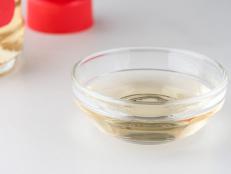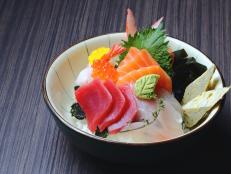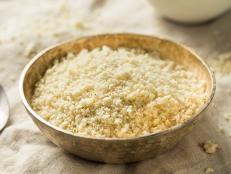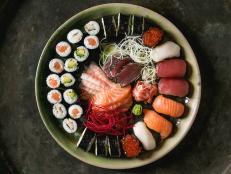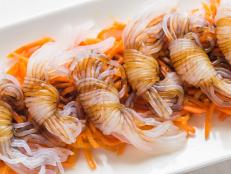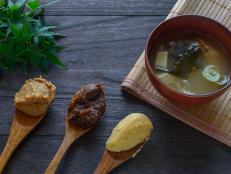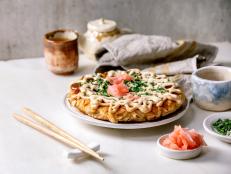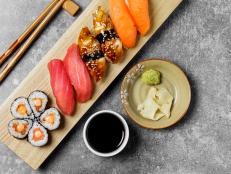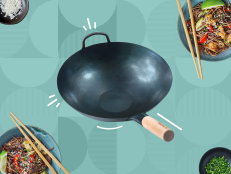What Is Mochi?
This sweet or savory delicacy has centuries of history.

Kenishirotie/Getty Images
By Layla Khoury-Hanold for Food Network Kitchen
Layla Khoury-Hanold is a contributor at Food Network.
Perhaps you know mochi as essential part of Japanese cuisine, or maybe you’ve simply spotted containers of ice cream mochi in the freezer section of your grocery store. But what exactly is mochi? For more info, we consulted Jane Matsumoto, Director of Culinary Arts at The Japanese American Cultural & Community Center.

Akiko Aoki/Getty Images
What Is Mochi?
Mochi is a Japanese rice cake made from a sweet glutinous rice called mochigome that is steamed, pounded into a smooth rice dough and then molded into different shapes.
“In America, mochi is frequently associated as a sweet dessert, or confectionery such as mochi ice cream or daifuku, which are filled with bean paste or fresh fruit such as strawberry,” Matsumoto says. “But the Japanese consume mochi in its simplest form, which is a pounded white rice cake that is served most frequently during the New Year.”
In Japan, there are also several traditional desserts that incorporate mochi but are not made exclusively with glutinous rice flour. For example, namagashi are “raw mochi” that are filled with bean paste and colored or flavored with matcha tea or pastel-hued dyes. Dango consist of skewers of small bite sized mochi pieces that are finished with sweet sauce or bean paste. Sakura-mochi are typically served in the spring and are wrapped or covered with a cherry blossom leaf.

Susumu Yoshioka/Getty Images
What Is Mochi Made Of
Mochi is made of mochigome, a Japanese variety of sweet glutinous rice, that is soaked overnight, steamed, pounded into dough and molded into various shapes. Some sweet mochi confections contain fillings such as bean paste, ice cream or fresh fruit.
Today, mochi is often commercially produced using machines, but in Japan, there are gatherings and ceremonies for making hand-made mochi. Matsumoto outlines the equipment and steps for making traditional mochi by hand:
Step one: Mill steamed rice. The hot, steamed rice is added to the top of a traditional usu, a large rice mill that stands about 2 feet off the ground; the top is carved out into the shape of a large bowl.
Step two: Pound into a ball. One person then rhythmically pounds the cooked rice with a kine, a huge, heavy wooden mallet or pestle, while a second person stands hunched over the usu to physically lift and turn the sticky, steaming rice that is made into a large elastic, stretchy “mochi ball.” Making large quantities this way can be physically taxing, so there may be multiple two-person teams involved.
Step three: Rest and shape. After the pounding-and-turning process yields a smooth, pliable rice dough, the mochi rests, and the large ball is further manually broken into pieces and shaped into round discs while it is still malleable. Mochi can be consumed at this point, without doing anything else to it. Frequently, it is powdered with potato starch to keep it from sticking together.

JGalione/Getty Images
Mochi History
Mochi is an important part of Japanese culture and history. Some believe that mochi first became popular during the Heian period to celebrate occasions like weddings, births and the new year. “The typical new year mochi is white, like the color of rice, and shaped into a palm-sized disc about an inch in thickness,” Matsumoto says. “This type of mochi is grilled on a pan, or toasted in an oven, and it can be served as-is or included into a traditional hot bowl of New Year soup, known as ozoni. This basic mochi is not intended to be flavored or sweet. Rather, it is enjoyed for its stretchy, elastic texture and complemented by the broth of the soup.” She adds that if white mochi is served by itself, it can be enhanced with a sweet soy sauce or dusted with kinako, a beige-colored soybean flour.
For new year celebrations, Japanese cooks historically made larger, disc-shaped, stacked white mochi in celebration of the new year as a symbol of good luck and auspiciousness. “The term for this is kagami — mirror — mochi,” Matsumoto says. “Two large mochi, the base being slightly larger than the top mochi are stacked with a dai dai, a tangerine-like citrus fruit to bring good luck, to honor ancestors and honor future generations.”
In Japanese culture, the eleventh day of January is considered particularly auspicious. “By then the stacked kagami mochi has dried out and is cracked. January 11 is the day for Kagami Biraki, or to break the stacked mirror mochi. It is considered bad luck to cut the mochi with a knife, so it is broken into bits with a mallet and then cooked into various dishes. It can be used for ozoni soup or made into oshiruko, a dessert red bean soup, or with various other sweet mochi confectionery.”

IslandLeigh/Getty Images
What Is Butter Mochi
Butter mochi is a popular sweet Hawaiian dessert that is made with butter, coconut milk and mochiko, a flour made from the same glutinous sweet rice that is used to make mochi. “It is said that butter mochi is more popular than brownies in Hawaii,” Matsumoto says. “It is found on every potluck table and in most pastry stores. It is made like a cake in a sheet pan, cut into rectangular or square pieces and has the texture of soft, buttery, sweet elastic cake.”
Recipes with Mochi

Yunhee Kim
Subbing sweet rice flour for all-purpose flour gives these fudgy, black cocoa-infused brownies a pleasant, soft chewiness like mochi. Be sure to allot enough time to make these—the batter is very loose and takes longer to set than in most brownie recipes.

Teri Lyn Fisher
Butter mochi is a staple of potlucks and parties in Hawaii, where it's beloved for its sweet, buttery taste and chewy, pleasingly dense texture. Add another layer of coconut by sprinkling the top of the batter with shredded coconut before baking. A little goes a long way, so take care not to cut the pieces too big.

Yunhee Kim
These doughnuts are all about texture. Mochiko, or sweet glutinous rice flour, teams with up tapioca flour to create bounciness and chewiness, while a small amount of all-purpose flour keeps imparts a lovely cakey chew.

Teri Lyn Fisher
If your cookie preference falls in the chewy camp, this easy mochi cookie recipe is for you. Soft sugar cookies bake up with a slightly crisp edge while the mochi-stuffed-center stays ooey-gooey. For the confetti, opt for oblong rainbow sprinkles rather than spherical, so they maintain their shape and color.

The technique for folding these classic frozen Japanese confections takes time to master, but don’t let that deter you from trying. Besides, they’ll be delicious no matter what they look like.
Related Links:






















